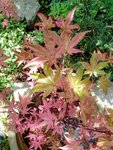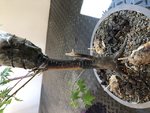Did you seal the trunk cuts in any way? It might be that case that their vascular system can't beat gravity.
I understand that we often cut downward roots on maples leaving open scars in the root ball to heal on there own without sealant. These scars have the benefit of being in very close proximity to healthy feeder roots. Even though that is the case, one can use sealant on the larger cuts to delay or prevent decay. The stubs we leave after air layering ( for reasons of stability) can often decay quickly creating poor conditions for the transplanted air layer.
It may be wise to remove the stub, seal and secure the new air layer by other means.
I have never sealed any air layer stub. If this is important, it is intriguing to think that covering exposed wood could erase the memory of which side of the branch was the underside (this is where the roots are and the area that becomes necrotic). Given the current circumstance, with two layers lying horizontal still with their stubs, I might remove the stub from one next spring (Feb 2021 -ish) and seal it with, say, Elmer's wood glue and then pot it vertically.
That is, assuming a layer without 'the necrosis' exists then. If so, I will have already demonstrated that keeping horizontal branches horizontal averts the necrosis issue. But it was done with stubs in place, which is far different from the wood exposure with the stub removed. Okay, I think
I'll put that on the list, despite feeling that I'm being so open minded that my brain is about to fall out.

But confirmation bias is a bad, bad thing IMHO.
Is it possible because you are pushing the boundaries of juvenility ( if that is a word)
I do think it is a word.
It might be true that all all the layers I've made have been lower (nearer the ground) on the tree. As I recall, though, a layer or two were at 2/3 to 3/4 the height of the tree. All failed in 'the necrotic way'. The one surviving layer was, I think, an extra apex. Just given these facts, I might conclude it is a juvenility thing. But I layered a slanting branch from this one successful layer and
necrosis appeared after it was harvested and potted (vertically in late May 2019). This, I think contradicts the idea that juvenility is a primary factor.
It seems like they're not turgid enough to get sap to the upper parts.
That's pretty much what it is, in effect. Air layer roots connect directly to that season's new wood. Death of the cambium over this layer provokes a CODIT reaction that clogs the xylem so water cannot be transported.
We know that there is more auxin in the polar auxin transport stream on the underside of a horizontal branch, hence adventitious roots tend to form on the underside.
We also know that when we prune a branch we stop the auxin flow from above. It can be sustained for a time by the upward flow of auxin laden phloem sap, but eventually the auxin level drops below some critical threshold and the cambium dies affecting CODIT sealing of the cut end.
So my hypothesis is that erecting and air layer of a previously horizontal branch reduces the auxin level in the PAT flow below this critical threshold --> cambium death (seen as blackish bark/necrosis) in the area of the adventitious roots.
There is an additional wrinkle, though. That is, this necrosis seems to be a spring thing, not happening in summer or fall. I don't understand this, but I do take it as a fact of this problem. Historically layers were potted vertically with the wad of sphagnum intact/insitu. They thrived through the end of the season. The following spring I combed out the sphagnum and removed the stub. No necrosis was noted. Subsequently they would start leafing out and would then suddenly collapse shortly after expressing first leaves. In the last few years of this history I noted the necrosis. I think it was there in the earlier years, but I overlooked it, as I remember being mystified by all the healthy roots and, in my naivete, didn't 'dig deeper',
So what goes on with the phytohormones that might explain why this is a spring thing? Any ideas?










